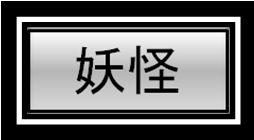Thanks to movies like “The Great Yokai War,” and comics and books like “Nura: Rise of the Yokai Clan” and “Yokai Attack!,” yokai as a word is slowly making its way into the English language. People are becoming aware of Japan’s legacy of magic and mystery. But, “yokai” is entering English with a meaning almost-but-not-quite the same as the Japanese meaning.
It is kind of like the word “manga”—in English, manga has come to mean “Japanese comics.” Exclusively. But in Japanese, manga just means … comics. All comics. Regardless of national origin. Iron Man? Manga. Mickey Mouse? Manga. Rex Morgan, M.D.? Manga. Tin Tin? Manga. And it doesn’t even specifically mean books (That would be “manga no hon.”) “Manga” can mean toys, movies, games … anything comic-related. It has a vast meaning beyond the limited scope of usage that we have given the word in English. I digress.
Of course, yokai can refer to Japan’s menagerie of monsters. All of the beasties and spirits—the baku, the kodama, the yuki onna, the kappa—all of these are yokai. I am as guilty as the next person for using yokai as a generic term for “Japanese monster.” It works. It fits. But that’s not the whole story.

Many other things are also yokai, things that are not creatures of any sort. Like the word manga, the Japanese usage of yokai has a much larger scope. It covers much more than just monsters.
(It is worth noting that “Nura: Rise of the Yokai Clan” isn’t called that in Japanese. The original title is “Nurarihyon no Mago” meaning “Nurarihyon’s Grandson.” The term “Yokai Clan” was tagged on to appeal to English readers.)
Breaking Down the Kanji – 妖怪
Like most Japanese words, the key to the meaning is in the kanji. So let’s start there.
Yokai uses two kanji;
- 妖 (yo) which means “mysterious, bewitching, unearthly, weird.” It doesn’t really have a scary nuance to it, but more of the attraction to something beyond the normal. It can be used in words like yoka (妖花) meaning an ethereally beautiful flower, or ayashii (妖しい) meaning bewitching or charming.
- 怪(kai) which means “mystery, wonder, strange.” Kai has more of a sense of horror, or the bizarre. It is the same kanji used in kaidan (怪談) meaning “weird tales” and kaiki (怪奇) meaning “bizarre, strange, outrageous.”
So, What Does Yokai Really Mean?
I think a better translation would be “mysterious phenomena”—or even “Fortean phenomena” if that means anything to you. “Mysterious phenomena” is probably better.
Along with folkloric creatures, yokai can refer to things like strange weather, mysterious illnesses, optical illusions, weird fruit, etc … And yokai is not limited to Japan. In his Yokai Encyclopedias, comic artist/folklorist/genius Mizuki Shigeru covers things like the Moai statues on Easter Island, or bigfoot and the yeti, or vampires and ghouls, or rains of frogs. Yokai is a broad, sweeping term that can cover pretty much everything weird on Earth.
Here’s what Japanese Wikipedia has to say:
“Yokai as a term encompasses oni, obake, strange phenomenon, monsters, evil spirits of rivers and mountains, demons, goblins, apparitions, shape-changers, magic, ghosts, and mysterious occurrences. Yokai can either be legendary figures from Japanese folklore, or purely fictional creations with little or no history. There are many yokai that come from outside Japan, including strange creatures and phenomena from outer space. Anything that can not readily be understood or explained, anything mysterious and unconfirmed, can be a yokai.”
That great arbitrator of all things yokai, Mizuki Shigeru, further breaks down the word yokai into four separate categories:
- Kaiju – 怪 (kai, mysterious) + 獣 (ju; beast), meaning “monster.” Most of Japan’s famous yokai are kaiju. Godzilla is a dai-kaiju, or “great monster.”
- Choshizen - 超 (cho; super) + 自然 (shizen; natural), meaning the supernatural, including mysterious natural phenomena.
- Henge - 変 (hen; strange) + 化(ge; to change, transform) , meaning shape-shifters like tanuki, foxes, and old cats.
- Yurei -幽 (yu; dim) + 霊 (rei; spirit), meaning ghosts, and spirits of the dead.
- Bakeneko is a yokai > henge
- Oiwa is a yokai > yurei
- Bigfoot is a yokai > kaiju
- Bermuda Triangle > yokai > choshizen
Yokai is a pretty old world, pre-dating most of Japanese folkloric vocabulary. The oldest known use of “yokai” is from the 1st century text “Junshiden” (循史伝) where the author writes “The yokai was in the Imperial Court for a long time.” The term is used to describe a sense of unnatural anxiety and foreboding. It shows up again in 772, in “Shoku Nihongi” (続日本紀) where a ritual cleansing of the palace is recommended to “clear away the yokai.” It isn’t used in the sense of any particular bad creature, but just accumulated “bad juju” that might be clinging to the palace.
Yokai as a term for Japan’s folkloric beasts didn’t really appear until the Edo period, with the publication of “Yokai Chakutocho” (夭怪着到牒 ), a yokai bestiary of the kind still familiar today. Sharp-eyed readers ( or those who know Japanese) will see that a different set of kanji was used; 夭 (yo, calamity, disaster ) + 怪 (kai). That kanji has a much more distinct menacing feel to it.

Texts from the Edo period also distinguish between types of yokai, such as “strange natural phenomenon” or “strange living things.” Also during the Edo period, when Japan began to have contact with other cultures, books began to be published of accounts of “Yokai of the West.”
Now you Know What Yokai Means!
Of course, this is the quick and dirty version. Whole books can and have been written on yokai, on the history of yokai, on the evolution and social meaning, etc … At least now when you want to start diving into things like that, you will have a clearer understanding of what the word yokai actually means!

No comments:
Post a Comment